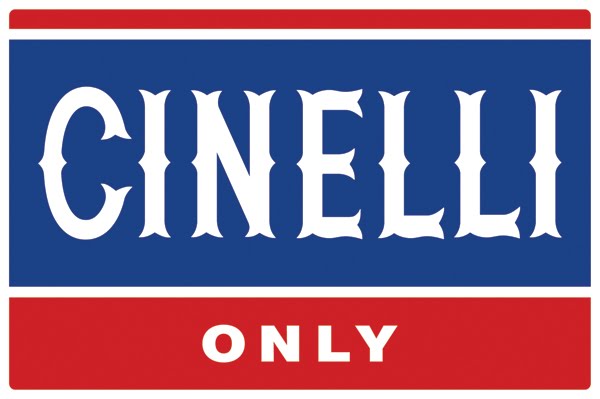The Cinelli Story (La Storia) by MARK PETRY
Cinelli frames have a loyal following with bicycle fans world wide. They were produced in small quantities (750 in the best years) till the company was sold to A.L. Columbo group in the late 70's. Cinelli frames made up until that point where used used mainly for Olympic and World Championship teams (ed. note: 1960 gold medal Olympic team were on Cinelli).
Cino Cinelli was a successful bicycle racer in Italy, winning Milan-San Remo in 1943 and. He started using some of the ideas he had created in his head during those year s of racing, when he began building frames after Word War II. Cinelli thought that frames needed to be stiffer and that the geometry was to relaxed on most of the models of that era. He created a fork crown that had sloping shoulders and internal lugs. This allowed the blades to be shorter and created a stiffer fork . Cinelli also redesigned the seat collar, bring the seatstays in behind the lug rather that along side it. Fausto Coppi was one of the first to use these new features when he raced on a Cinelli frame in 1947.
Cinelli also was known for components, his steel stems and bars where classic. There where a number of innovations that he brought to cycling. The first clipless pedal, the M71 was released in 1971.
The first aluminum handlebars to be accepted by the pros. The first plastic saddle, the Unicantor was designed in 1962 and became the model which all of todays saddles are based.
Hub design was an area that Cinelli put his trademark on with the introduction of the Bivalent q/r hubs. This design left the freewheel behind in the frame, and the wheel could be used in the front or rear. The idea was ahead of it's time, and the cost which was about twice what a Campagnolo hub would cost.
Cinelli also created the Laser bicycle which was one of the first aero “funny” bikes. This model was used to win many national and world titles. Ole Ritter used a Cinelli to set the hour record in 1968. This model had longer cranks and Campagnolo hubs that were 2 cm. narrower than conventional hubs. This bike ran on special tubulars made just for this record attempt. The bike also had a special fork with winged shaped blades for lower wind resistance.
In Italy the professional racers have a special attachment to Cino Cinelli. The relationship developed between Cino, Gino Bartali and Fausto Coppi. Cino was the foundation of the Italian Professional Cycling Association for professional riders. The idea was to represent the riders interest in the Italian Bicycling Federation, as well as the Italian Sports Federation (CONI). Cino was the president of the association for 24 years. His book on training for cycling remains a classic to this day.
Cinelli serial numbers do not run in sequence. Only in the post - 1981 timeframe (corresponding to the sale of the company to A.L. Columbo) do the serial numbers indicate the date. Some frames may have sat unsold for years in the shop, others may have been built by subcontractors.
The key to dating a Cinelli are the lugs (3 holes or no hole) and the bottom bracket oil port. The presence or absence of these features will help to establish the manufacturing date of a Cinelli frame. The BB port disappeared in about 1965. The 3 holes in the lugs appeared in about 1968. The Special Corsa ("A" model) is distinguished by its sloping fork crown, where the "B" model has a conventional flat fork crown.
There may have been a factory lightweight model, featuring a milled BB - 3 such bikes are known (ed. note: there was a lightweight model with a drilled BB; see http://italiancyclingjournal.blogspot.com/2007/08/reminiscing-about-my-1972-cinelli.html)
Steven Maasland contributed the following on the debate recently about the significance of the SC on Cinelli bikes, I wrote to Andrea Cinelli to see if he could shed any light onto the matter. The question was, essentially, what is the difference between a Speciale Corsa and a Super Corsa. His response was:
"Le etichette "Speciale Corsa" e "Supercorsa" identificano lo stesso modello di telaio o bici: venivavo abbreviate "S.C.", in cui la "S" indicava "Speciale" o "Super", mentre la "C" indicava "Corsa", per differenziare il modello più economico: "modello B"."
Which translates to: The labels Speciale corsa and Supercorsa identified the same model of frame or bike: they were abbreviated "S.C.", in which the "S" indicated "Speciale" or "Super", whereas the "C" indicated "Corsa", to differentiate from the more economical model: "Modello B."
"Avevamo temporaneamente esaurito un' etichetta e per un equivoco dello stampatore la lettera "S" ha avuto due significati diversi. Errori simili succedevano in passato anche con i francobolli con grande "soddisfazione" dei collezionisti che lucravano prezzi più alti sul mercato."
Which translates to: We had temporarily run out of a label and due to a printer's error, the letter "S" had two different meanings. Similar errors have also happened in the past with postage stamps to the great "satisfaction" of collectors who have sought more lucrative prices on the market.
It would therefore appear that there is no intended difference whatsoever between the two denominations."
I invite you to contribute by sending in photographs of your Cinelli bike, illustrations, personal stories, and articles about Cinelli bikes and components.
Thanks for stopping by.
I can be contacted at veronaman@gmail.com

I spoke with Mark and he said this article appeared in an Italian magazine and it was translated into English.
ReplyDelete